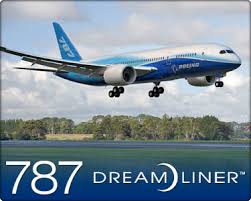
Responding to the overwhelming preference of airlines around the world, Boeing Commercial Airplanes' new airplane is the Boeing 787 Dreamliner, a super-efficient airplane. An international team of top aerospace companies is developing the airplane, led by Boeing at its Everett facility near Seattle, Wash.
Unparalleled Performance
The 787-8 Dreamliner will carry 210 - 250 passengers on routes of 7,650 to 8,200 nautical miles (14,200 to 15,200 kilometers), while the 787-9 Dreamliner will carry 250 - 290 passengers on routes of 8,000 to 8,500 nautical miles (14,800 to 15,750 kilometers). A third 787 family member, the 787-3 Dreamliner, will accommodate 290 - 330 passengers and be optimized for routes of 2,500 to 3,050 nautical miles (4,600 to 5,650 kilometers).
In addition to bringing big-jet ranges to mid-size airplanes, the 787 will provide airlines with unmatched fuel efficiency, resulting in exceptional environmental performance. The airplane will use 20 percent less fuel for comparable missions than today's similarly sized airplane. It will also travel at speeds similar to today's fastest wide bodies, Mach 0.85. Airlines will enjoy more cargo revenue capacity.
Passengers will also see improvements with the new airplane, from an interior environment with higher humidity to increased comfort and convenience.
Advanced Technology
The key to this exceptional performance is a suite of new technologies being developed by Boeing and its international technology development team.
Boeing has announced that as much as 50 percent of the primary structure - including the fuselage and wing - on the 787 will be made of composite materials.
An open architecture will be at the heart of the 787's systems, which will be more simplified than today's airplanes and offer increased functionality. For example, the team is looking at incorporating health-monitoring systems that will allow the airplane to self-monitor and report maintenance requirements to ground-based computer systems.
Boeing has selected General Electric and Rolls-Royce to develop engines for the new airplane. It is expected that advances in engine technology will contribute as much as 8 percent of the increased efficiency of the new airplane, representing a nearly two-generation jump in technology for the middle of the market.
Another improvement in efficiency will come in the way the airplane is designed and built. New technologies and processes are in development to help Boeing and its supplier partners achieve unprecedented levels of performance at every phase of the program. For example, by manufacturing a one-piece fuselage section, we are eliminating 1,500 aluminum sheets and 40,000 - 50,000 fasteners.
Post a Comment